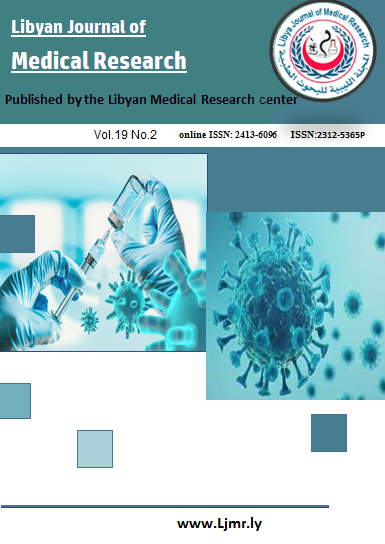Phenotypic and Antibiogram Profile of Bacteria Isolated from Diabetic Foot Ulcers
DOI:
https://doi.org/10.54361/LJMR.19.2.12Keywords:
Diabetic Foot Ulcers, Gram-negative bacteria, Antibiogram, multidrug-resistant (MDR) bacteria, LibyaAbstract
Background: Diabetic foot ulcers (DFUs) represent a severe complication of diabetes mellitus, frequently progressing to infections that challenge clinical management and increase amputation risks. This study aims to characterize the bacterial etiology and antimicrobial resistance patterns of DFU isolates in Libyan patients. Material and Methods: From March to June 2024, 39 wound samples were collected from DFU patients at Abu Salim Trauma Hospital, Tripoli. Wound sites were cleansed with sterile saline, and samples were cultured aerobically for bacterial isolation using standard bacteriological media. Bacterial identification and antimicrobial susceptibility testing were performed using automated systems (BD Phoenix M50 and MA120 Render). Statistical analyses assessed associations between demographic factors (e.g., age, sex), ulcer severity, and microbial profiles. Results: Of 39 samples, 17 yielded pathogenic bacterial isolates (24 culture-positive, with 7 excluded as contaminants), with Gram-negative bacteria predominating (76.5%). Pseudomonas aeruginosa (35%) and Staphylococcus aureus (23%) were the most common. Three isolates (17.6%) exhibited multidrug resistance (MDR), defined as non-susceptibility to at least one agent in three or more antimicrobial classes, including one carbapenem-resistant P. aeruginosa (CRPA) and two methicillin-resistant S. aureus (MRSA). Gram-negative dominance was associated with severe ulcer grades (p = 0.03 ). Age (>60 years; OR = 3.2, p = 0.03 ) and ulcer severity (OR = 4.8, p = 0.01 ) predicted MDR phenotypes. Conclusion: The presence of MDR pathogens in DFUs shows the need for enhanced surveillance, antibiotic stewardship, and tailored therapeutic strategies in Libya to improve patient outcomes and combat resistance.
Downloads
References
1. Armstrong DG, Boulton AJM, Bus SA. Diabetic foot ulcers and their recurrence. N Engl J Med. 2017;376(24):2367-75.
2. McDermott K, Fang M, Boulton AJM, Selvin E, Hicks CW. Etiology, epidemiology, and disparities in the burden of diabetic foot ulcers. Diabetes Care. 2023;46(1):209-21.
3. Jodheea-Jutton A, Hindocha S, Bhaw-Luximon A. Health economics of diabetic foot ulcer and recent trends to accelerate treatment. Foot (Edinb). 2022;52:101909.
4. Sadeghpour Heravi F, Zakrzewski M, Vickery K, Armstrong DG, Hu H. Bacterial diversity of diabetic foot ulcers: current status and future prospects. J Clin Med. 2019;8(11):1935.
5. Percival SL, McCarty SM, Lipsky B. Biofilms and chronic wounds. Antimicrob Agents Chemother. 2018;59(4):e01657-14.
6. Zubair M. Clinico-microbiological study and antimicrobial drug resistance profile of diabetic foot infections in North India. Foot (Edinb). 2020;46:101710.
7. Jouhar L, Jaouadi H, Abdelkafi Koubaa A, Ben Brahim H, Smaoui F. Antibiotic resistance in diabetic foot ulcer infections in a Tunisian hospital. J Infect Dev Ctries. 2020;14(1):48-55.
8. Najari BB, Kashani HH, Nikzad H, Azizian M. Antibiotic resistance in patients with diabetic foot ulcer in a referral center in Iran. J Diabetes Metab Disord. 2019;18(1):89-95.
9. Mutonga DM, Khamadi SA, Okemo PO. Bacterial isolates from diabetic foot ulcers and their susceptibility patterns at Kenyatta National Hospital, Nairobi. East Afr Med J. 2019;96(1):1-10.
10. Dai J, Jiang C, Chen H, Chai Y. Risk factors for multidrug-resistant organisms in diabetic foot ulcers. J Diabetes Res. 2020;2020:8864896.
11. AL-Sahi AM, Elramalli AK, Alawami AH, Amri SG. Microbial profile and antibiotic resistance patterns of diabetic foot infections in Tripoli, Libya. Libyan J Med. 2023;18(1):2156768.
12. Coşkun Ö, Şenel E, Demir E, Acar A. Microbiological profile and antibiotic susceptibility patterns of diabetic foot infections in a tertiary care hospital in Turkey. J Foot Ankle Res. 2024;17(1):12.
13. Hefni HA, Ibrahim AM, Attia KM, Moawad AA, El-Rahman OA, Elatriby MA. Microbiological profile of diabetic foot infections in Egypt. J Arab Soc Med Res. 2013;8(1):26-32.
14. Elramalli AK, Amri SG, Alawami AH, AL-Sahi AM. Antibiotic resistance patterns of Pseudomonas aeruginosa isolated from diabetic foot ulcers in Libya. J Glob Antimicrob Resist. 2018;15:178-83.
15. Kieffer N, Nordmann P, Poirel L. Pseudomonas aeruginosa resistance to antibiotics in Libya: a review of the current situation. J Glob Antimicrob Resist. 2018;15:160-5.
16. Ugwu E, Adeleye O, Gezawa I, Okpe I, Enamino M, Ezeani I. Predictors of lower extremity amputation in patients with diabetic foot ulcer. Int J Low Extrem Wounds. 2024;23(1):34-42.
17. Shi Y, Hu FB. The global implications of diabetes and cancer. Lancet. 2022;399(10335):1671-2.
Downloads
Published
Issue
Section
License
Copyright (c) 2025 Abdulgader Dhawi, Bushra E. Aboukhadeer, Khalid M. Atbeeqah, Hajar M. Abuzaid, Nehal N. Diab (Author)

This work is licensed under a Creative Commons Attribution-NonCommercial-NoDerivatives 4.0 International License.
Open Access Policy
Libyan journal of medical Research (LJMR).is an open journal, therefore there are no fees required for downloading any publication from the journal website by authors, readers, and institution.
The journal applies the license of CC BY (a Creative Commons Attribution 4.0 International license). This license allows authors to keep ownership f the copyright of their papers. But this license permits any user to download , print out, extract, reuse, archive, and distribute the article, so long as appropriate credit is given to the authors and the source of the work.
The license ensures that the article will be available as widely as possible and that the article can be included in any scientific archive.
Editorial Policy
The publication of an article in a peer reviewed journal is an essential model for Libyan journal of medical Research (LJMR). It is necessary to agree upon standards of expected ethical behavior for all parties involved in the act of publishing: the author, the journal editorial, the peer reviewer and the publisher.
Any manuscript or substantial parts of it, submitted to the journal must not be under consideration by any other journal. In general, the manuscript should not have already been published in any journal or other citable form, although it may have been deposited on a preprint server. Authors are required to ensure that no material submitted as part of a manuscript infringes existing copyrights, or the rights of a third party.
Authorship Policy
The manuscript authorship should be limited to those who have made a significant contribution and intellectual input to the research submitted to the journal, including design, performance, interpretation of the reported study, and writing the manuscript. All those who have made significant contributions should be listed as co-authors.
Others who have participated in certain substantive aspects of the manuscript but without intellectual input should only be recognized in the acknowledgements section of the manuscript. Also, one of the authors should be selected as the corresponding author to communicate with the journal and approve the final version of the manuscript for publication in the LJMR.
Peer-review Policy
- All the manuscripts submitted to LJMR will be subjected to the double-blinded peer-review process;
- The manuscript will be reviewed by two suitable experts in the respective subject area.
- Reports of all the reviewers will be considered while deciding on acceptance/revision or rejection of a manuscript.
- Editor-In-Chief will make the final decision, based on the reviewer’s comments.
- Editor-In-Chief can ask one or more advisory board members for their suggestions upon a manuscript, before making the final decision.
- Associate editor and review editors provide administrative support to maintain the integrity of the peer-review process.
- In case, authors challenge the editor’s negative decision with suitable arguments, the manuscript can be sent to one more reviewer and the final decision will be made based upon his recommendations.













